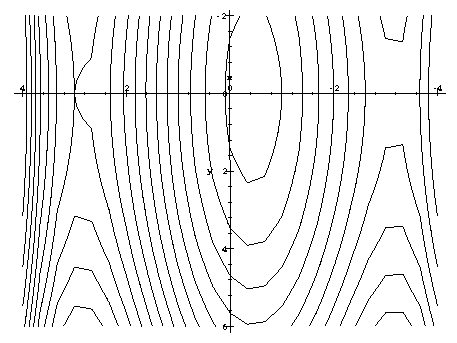Differentiating a function of more than one variable is more complicated than differentiating a function of one variable. For a function of several variables the rate of change of the function depends on direction!. Consider the function
![]()
which is shown as a surface in xyz space below.

Let us assume that the surface corresponds to a mountain and assume that we are a mountain climber located the peak near x=0 and y=0. Note that if we travel in the positive x direction, the elevation decreases rapidly. The derivative in the x direction is negative and has a large magnitude. On the other hand, if we travel in the positive y direction, the elevation changes slowly. We can travel in any direction, not only parallel to the x and y axes, and the derivative depends on the direction.
Another way to display a function of two variables is by a contour plot. You have seen contour maps. Points with the same elevation are joined by lines. You have seen weather maps where points with equal temperature are joined by lines (these lines are called isotherms). A contour plot of the function z=f(x,y) consists of a family of curves f(x,y)=c (called level or contour curves) in the xy plane for various values of c. On the curve f(x,y)=c, z=c. A contour plot of the model function is shown below:

On each curve in the contour plot z =f(x,y) is constant. On different curves the constant is different. We haven't listed the values of z on the various curves above. However, by comparing the plot of the surface with the contour plot, we conclude that the oval contour near the origin corresponds to a large value of z, for example. Note that if one moves in the negative x-direction from the origin, then one crosses a number of contour curves in a short distance. This implies a rapid change in function value. If one travels in the y-direction, one does not cross as many contour curves in a short distance; the change in the function value is less rapid.
We are now ready to discuss partial derivatives. Suppose we are interested in determining the rate of change of z=f(x,y) for fixed y. For example, let y=0 in our model problem. Then
![]()
z is a function of the single variable x. dg/dx can be computed using techniques from single variable calculus. g'(x)=4x^3+3x^2-36x-16. In general for arbitrary y, the derivative in the x direction is called the partial derivative with respect x and is defined by
![]()
In the definition y is held fixed. To compute the partial derivative with respect to x we differentiate with respect to x and assume y is a constant. For the model problem we have
![]()
Similarly we can compute the partial derivative with respect to y. It is defined by
![]()
Note that now x is held fixed. To compute the partial derivative with respect to y we differentiate with respect to y and assume x is a constant. For the model problem we have
![]()
To determine the derivatives at a particular point in the xy plane, we subsitute the coordinates of the point in the formulas for f_x(x,y) and f_y(x,y). For example, at the origin x=0 and y=0 and f_x(0,0)=-16 and f_y(x,y)=0. These numbers support the arguments based on the plot of the surface and contour plot. The function changes more rapidly in the x direction than in the y direction.
For the function
![]()
find the partial derivatives of f with respect to x and y and compute the rates of change of the function in the x and y directions at the point (-1,2).
Initially we will not specify the values of x and y when we take the derivatives; we will just remember which one we are going to hold constant while taking the derivative. First, hold y fixed and find the partial derivative of f with respect to x:
![]()
Second, hold x fixed and find the partial derivative of f with respect to y:
![]()
Now, plug in the values x=-1 and y=2 into the equations. We obtain f_x(-1,2)=10 and f_y(-1,2)=28.
We can of course take partial derivatives of functions of more than two variables. If f is a function of n variables x_1, x_2, ..., x_n, then to take the partial derivative of f with respect to x_i we hold all variables besides x_i constant and take the derivative.
To find the partial derivative of f with respect to t for the function
![]()
we hold x, y, and z constant and take the derivative with respect to the remaining variable t. The result is
![]()
[Vector Calculus Home] [Math 254 Home] [Math 255 Home] [Notation] [References]
Copyright © 1996 Department of Mathematics, Oregon State University
If you have questions or comments, don't hestitate to contact us.